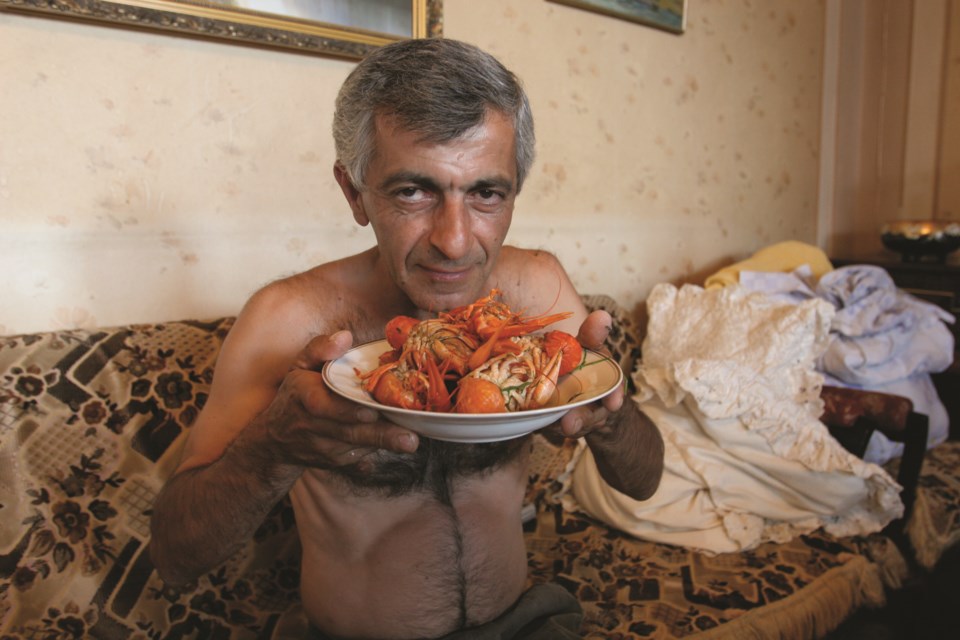I found my first Armenian viper a hundred metres from camp.
High on a windswept col, I’d been searching around a crumbled stone shepherd’s hut. Twisted chunks of cheap Soviet sheet-metal lay scattered amidst an abundance of the corrugated, asbestos-composite roof tile diagnostic of all former Soviet states in Asia Minor—as if some Moscow functionary decreed that every dwelling in the southern empire adopt the same dull grey pallor in order to promote unity. This was a generous assessment; the tile—an inferior material that went brittle in the sun and disintegrated into toxic dust—more likely promoted asbestosis.
Finding nothing, I’d headed back toward the tents. Passing another pile of haphazardly stacked roofing, I’d absently flipped a piece with the toe of my boot, exposing nothing but scurrying earwigs. Beneath it was a second slab. And beneath that was the viper.
It lay tightly coiled, a chocolate, tangerine-spotted band hovering like a Magritte illusion over bland grey, as if it, too, were fighting the soulless rule of communism. This perfect juxtaposition of natural and unnatural was tantamount to finding buried treasure—in the same instant serendipity and deserved reward for a godforsaken trip.
For a moment, my reverence knew no bounds: the Armenian viper was the most beautiful thing I’d ever seen.
Then it moved.
Though I knew better from years spent in his company, I’d consented to accompanying my former doctoral supervisor, Dr. Bob, to this heat-blasted land to study the endangered Armenian viper. Conservation and journalistic goals overrode memories of past Bob-style expeditions: stretched out in the fetid box of a pickup truck in the searing Baja desert, a bag of live rattlesnakes at my feet… curled sick and fetus-like on a pool table at 40 Celsius and 90-per-cent humidity in a banana warehouse in Vietnam, sweat stains spreading like blood across the green felt… and being held at gunpoint—pretty much everywhere we’d gone together.
On a hot July night in 2006, I’d exited the airport in Armenia’s capital, Yerevan, and scanned the crowd. It didn’t take long to spot Bob, face obscured by a massive camera, taking pictures of me… looking for him. The digital photo revolution had pushed hobbyists like Bob to new heights on the useless-photo ladder. At least he no longer risked being arrested for carrying illegal film because postage-stamp memory cards were so much easier to hide.
Nikolai “Kolya” Orlov, from the Russian Academy of Sciences in St. Petersburg, stood to Bob’s side, meaty hands stretching inadequate pockets. A mercenary snake wrangler with a dozen Armenian expeditions under his belt from the country’s days under the (broken) USSR umbrella, I’d been in Vietnam with Kolya twice, where he’d proven invaluable in dealing with communist bureaucracies, exchanging foreign currency, and wrangling venomous reptiles. Alone among us he truly knew no fear when it came to snakes or food, the latter getting him in far more trouble.
Clasping hands, we half-hugged L.A.-gang style as Bob took a photo and turned the display to us, like a beach vulture hawking vacation shots. “Bop,” groaned Kolya, his truncated pronunciation chopping the last consonant as he rolled his eyes in mock disgust. I hadn’t seen these two together in a decade, but it may as well have been last week.
In Kolya’s considerable shadow lurked our diminutive Armenian host, Aram Aghasyan, whose abiding trait was a permanently smouldering cigarette. Aram lived in a cluster of Stalinesque high-rises in northern Yerevan; bleak towers of disintegrating concrete with garbage chutes that fired waste directly to the ground outside where an army of dogs distributed it in all directions. My duffel barely hit the floor in his cramped three-bedroom flat before a king’s banquet of roast chicken, cucumber, tomato, pepper, sour cheese, and bread appeared. Aram’s wife, Margo, and son, Levon, hectored us toward the table. I was embarrassed thinking they’d waited dinner on me, but they hadn’t: it was all for me.
Tradition dictates that after a long journey—the only kind one can make in Asia Minor—you put out food and drink for the traveller. I dug in while the others picked listlessly over a plate of suppurating watermelon. Except Aram, who was busy dissecting a bucket-load of extra-large Sevan crayfish fetched from the eponymous post-Pleistocene lake that pooled in the country’s midsection, his appetite for these organisms as great as it was for cigarettes. An indeterminate number of vodka toasts later, I lay in the dark on a church-bench-stiff sofa that also proved a head too short—a discomfort I’d only suffer for the next three weeks. I would have gladly slept on the floor, but I’d already seen a swarm of cockroaches scatter when I turned on the light in the phone-booth-sized bathroom. I nodded off only after surrendering to the fact that the start of Bob’s expeditions were usually far worse: this time there’d been no shakedown in customs, no hovering government officials, no side trip to any ministry, no one to pay off, and, so far, no radical change of plans.
Thirty minutes later, an entire nation’s worth of ownerless dogs cranked up, and the tortuous squeals of fighting and copulation continued until dawn, when the hounds handed off to the birds for an hour in a triumphant coda that heralded the end of any hope for sleep.
Next time: Hitting the road.
Leslie Anthony is a Whistler-based author, editor, biologist and bon vivant who has never met a mountain he didn’t like.




